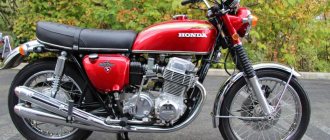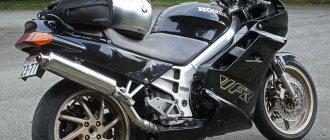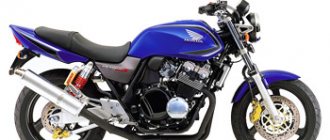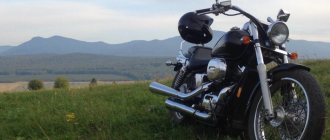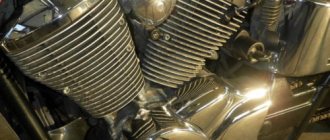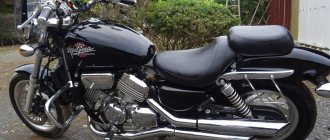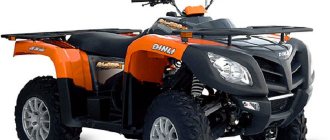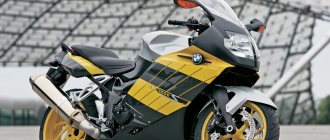The Hurricane model, officially named Honda CBR600F, was already mentioned on the project as a prototype for the 600 cc RR. But five (5!!!) generations, the tough fight for the championship with Fazer (FZ6) from Yamaha and the decision to restore production after a 5-year inactivity are worthy every respect.
First appearing in 1987, it was produced for 18 years.
In 2006, the fifth generation was removed from the assembly line. Then 2011 comes and the model goes into production again, although only the name remains from the Hurricane. Everything changes, from frame material to driving characteristics - a motorcycle from a sports motorcycle becomes a road bike . And in 2013, the Honda CB600F Hornet model finally goes down in history. Place on the assembly line is transferred to the more powerful, more modern Honda CB650F.
Model overview
40 years of evolution and technical progress have given us today a fairly powerful, compact, beautiful and technically well-equipped middle-class motorcycle - the Honda CB 400 Super Four Hyper VTEC 4 versions REVO and BOLDOR.
The motorcycle is equipped with a 4-cylinder, 16-valve water-cooled engine with a displacement of 399 cm³. The car was created for the Japanese domestic market, because there are restrictions for beginner motorcyclists: the engine volume should not exceed 400 cm³, and the power should not exceed 53 hp. The engine is also equipped with an electronic injection system PGM-FI Fuel and a VTEC system.
VTEC works as follows: because the engine is 16-valve (4 valves per cylinder), then from 1st to 5th gear up to 6300 rpm only 2 valves per cylinder are used in the engine operation, the second pair of valves is activated above 6300 rpm and at a fully open throttle to increase power . In 6th gear, all 16 valves are engaged in engine operation.
The appearance of the motorcycle leaves no one indifferent - not only the driver gets pleasure from riding it, but also all passers-by turn around and follow this beautiful car with their eyes.
In terms of design, the motorcycle belongs to the “naked bike” class: it completely lacks plastic panels and fairings, the headlight is round, and the speedometer and tachometer are not covered in any way. The exception is the BOLDOR version: it is equipped with a front fairing and a square headlight .
The riding position on the motorcycle is classic, not sporty, so long-distance trips are not tiring, but for them it is better to have at least a little wind protection, or a BOLDOR version with a fairing: the motorcycle reaches a maximum speed of up to 190 km/h, which is quite a high figure, and At such speeds, drag increases greatly.
The motorcycle is very practical, has a relatively light weight, and is compact in size, making it well suited for dense city traffic and maneuvering between cars in traffic jams.
The motorcycle has a fairly powerful braking system - a large 2-disc brake at the front and a single-disc brake at the rear. The motorcycle has high dynamic characteristics - it accelerates to 100 km/h in 4.5 seconds.
All models of Honda motorcycles in the lineup have impressive characteristics, in each group of motorcycles by type.
Fuel consumption per 100 km in city mode is 4-8 liters, depending on the driver’s driving style.
The figures are so high because the CB400 engine is a modified CBR400RR engine. The modification consisted of increasing torque at low speeds and reducing fuel consumption compared to a sports motorcycle.
The design of the hero of our article is very close to English and resembles Triumph motorcycles. The model range can be found in our article.
The older brother from the Honda lineup was also not deprived of our attention, read here. Review of the motorcycle and its technical characteristics.
Flaws
- Low windshield . But the problem is solved by installing a tuned, higher one.
- Rear signal installation failed . Being in the rear stem, it is set back and down by default. It may not be visible to the driver behind a driving Kamaz. When installing a case, most users duplicate the stop on its reflectors.
- Lack of handles for the second number . For city driving it is not critical, but when installing side panniers, securing them is a problem.
- Headlight . The shape under the fox eyes did not bring much benefit. Users recommend installing xenon.
Owners of the first assemblies of the fourth generation say that the timing chain tensioner rattles at low speeds. It can be cured by installing the latest version.
and dignity
- Suspension. The soft system itself with a full range of settings allows you to choose the optimal performance for a wide variety of routes.
Shock absorption adjusters allow the rider to change the stiffness of the suspension at his discretion.
- Saddle . Double saddle like a road bike with the softness of a sofa. Paired with the suspension it compensates for any road problems.
- Landing . When cruising on the highway or leisurely around the city, you can sit like a classic - no problems, if you want to “fry” at 180, you will have to lie down on the tank.
- Mirrors . The mount, which is non-standard for the concern, allows you to configure it in such a way that even a biker with broad shoulders will not block the road behind.
- Engine . Good traction at all speeds, not “evil” character.
- Ease of control . Although the bike cannot be called light, it is well suited for girl bikers who want a Japanese, not a Chinese, “trotter”.
- Frame rigidity . Fourth generation bikes (2001–2006) are often chosen by those who like to rock out. A powerful motor and a strong frame allow you to “take on anything.” On the one hand, this is a plus, but the used buyer needs to be careful. The resource of parts is huge, but not infinite.
Maneuverability, controllability, dynamics - these are the epithets that characterize the “winglet” of both the first and second waves.
The slider is a very useful thing that saves fragile plastic from unplanned sliding on the asphalt.
Brief history of the model
- 1988 - start of production and sales of the Honda CBR 400 RR model, which replaced the Honda CBR 400 R Aero. This year's models have the Hurricane prefix on the lower side plastic. The first generation of the motorcycle. The frame number is NC23. The full model name is CBR400RR-J.
- 1989 - full model name - CBR400RR-K. The Hurricane prefix is removed from the plastic.
- 1990-1991 - second generation of the motorcycle. The frame number is NC29. The full model name is CBR400RR-L.
- 1992-1993 — full model name — CBR400RR-N.
- 1994 - full model name - CBR400RR-R. Starting this year, the model receives the Fireblade prefix at the top of the side plastic.
- 1999 is the last year of production of the Honda CBR 400 RR.
Honda CB-1(Honda CB400F)
A serial Japanese classic motorcycle that was produced from 1989 to 1992. The motorcycle was equipped with a four-stroke engine with a volume of 399 cm³.
The Honda CB-1 was first introduced in 1989. Originally developed for the Japanese domestic market, it later became available in the US and Canada.
Specifications
In terms of its parameters, this motorcycle is very good. Its performance even today is impressive and makes the model interesting for those who want to buy a cheaper motorcycle, but in good condition. This is a reliable car that has a very long service life, so even if it has been driving for more than a dozen years, its condition can be excellent.
Engine
The inline four shows good maximum performance: torque is 40 Nm and power is 53 hp. These are not such small figures for a unit with a volume of 399 cm³. The speed limit here is 190 km/h. For a small entry-level sportbike, you don’t need anything more powerful.
Class
| Classic 9 Sports 14 | Streetfighter 2 |
Engine capacity
docub. cm.
Transmission
The gearbox here is six-speed, and the drive is of a chain type. Thanks to this transmission, the Honda CBR 400 RR can accelerate well in any of the six gears. In addition, due to the type of drive, power is not lost when the motor potential transfers to the wheel.
Dimensions and weight
The motorcycle has average dimensions for the class: its wheelbase is 1375 mm, its height is 1080 mm, its length is 1990 mm, its width is 670 mm, and its seat height is 750 mm. The weight of the CBR 400 RR is 170 kg, and its tank volume is 15 liters. Fuel consumption greatly depends on driving style. In an aggressive sports race, up to 10 liters can be spent per hundred kilometers, while during quiet movement, about 5 liters can be spent.
Chassis and brakes
The frame of the bike is diagonal and made of aluminum. The latter circumstance makes the motorcycle lighter and much more in line with the sporty direction of the motorcycle than, for example, a steel one. The wheels are alloy and look very elegant, despite their simplicity.
At the rear, a progressive monoshock absorber is used as suspension. At the front, a 41 mm telescopic fork is used. The rear brake features a 220 mm disc along with a two-piston caliper, while the front uses a pair of 275 mm discs along with four-piston calipers.
Fuel consumption
The average fuel consumption of the Honda CBR 400 RR is 5-6 liters in quiet mode and up to 10 liters per 100 km in aggressive driving style.
Honda CBR 600RR
Honda sports bike with 4 cylinders, engine capacity - 599 cubic centimeters, 6 gears. Produced until 2008. Depending on the year of production, the number of horsepower changed slightly, now there are 118. The maximum speed is 254 km/h. This motorcycle won the championship in the Supersport class seven times in a row, moreover, in the 2008 season it took all three positions on the podium.
In 2013, a new generation of this bike was released. The class of 600cc sports motorcycles is gaining momentum every year - even pilots who traditionally chose “liters” are little by little beginning to switch to “600cc” motorcycles. This is understandable - motorcycles of this class are easier to handle, cost a little less than their older brothers, and on tracks, at least Russian ones, they show almost a “liter” lap time. And one of the biggest names in this sportbike class is, of course, the Honda CBR600RR.
The motorcycle rides and handles great, and, in comparison with its closest competitor, the Yamaha YZF-R6, is much more flexible and rider-friendly, which makes it better suited for daily travel around the city. By the way, it is city riding in our realities that is the main habitat of sportbikes, and forays on the track and motorcycle racing, on the contrary, are sporadic. And for such conditions, the six hundredth “Siber” is perfectly suited.
Production
The motorcycle was produced from 1988 to 1999, which in itself speaks of its popularity. However, even after so many years, it continues to remain very relevant, especially if a person does not have much money, but the desire to purchase at least some kind of sports bike is enormous.
Technical characteristics of CBR400 R on nc23 frame
CBR400 Aero / CBR400 RRK
| Specifications/Models | CBR400RG (Aero) | CBR400 RH-Ya (Aero) | CBR400RRJ | CBR400RRK |
| Year of issue | 1986 | 1987 | 1988 | 1989 |
| Frame number from... / to... | NC23-1000027 | NC23-1015001 | NC23-1020011 | NC23-1090001 |
| NC23-1010690 | NC23-1016160 | NC23-1036454 | NC23-1098116 | |
| Engine number from... / to... | NC23E-1000042 | NC23E-1015002 | NC23E-1020001 | NC23E-1090001 |
| NC23E-1010736 | NC23E-1016192 | NC23E-1036510 | NC23E-1098123 | |
| Carburetor | VG02A-A | VG02A-E | VG04A-A | VG04B-A |
| L × W × H (mm) | 2015 × 685 × 1095 | 2020 × 690 × 1110 | ← | |
| Wheelbase (mm) | 1380 | 1370 | ← | |
| Ground clearance (mm) | 140 | 120 | ← | |
| Seat height (mm) | 765 | 765 | ← | |
| Weight / Dry weight (kg) | 184 / 165 | 179 / 162 | ← | |
| Engine capacity (cm3) | 399 | ← | ← | ← |
| Fuel consumption (km/l) | 43 (~60 km/h) | 38.1 (~60 km/h) | ← | |
| Diam. cylinder × piston stroke | 55 × 42 (mm) | ← | ← | ← |
| Compression ratio | 11:1 | 11.3:1 | ← | |
| Max. power (hp/rpm) | 59 / 12 500 | 59 / 12 500 | ← | |
| Max. torque (Nm/rpm) | 3.8 / 10 000 | 4 / 10 000 | ← | |
| Gas tank volume (l) | 16 | ← | 15 | ← |
| Gearbox (stages) | 6 | ← | ← | ← |
| Gearbox ratios: | ||||
| 1 | 3,307 | ← | ||
| 2 | 2,352 | ← | ||
| 3 | 1,875 | ← | ||
| 4 | 1,590 | ← | ||
| 5 | 1,434 | ← | ||
| 6 | 1,280 | ← | ||
| Suspension: | ||||
| Front fork | Telescopic, air-oil. Made by Showa | ← | ← | |
| Fork diameter (mm) | 41 | ← | ||
| Rear swingarm | Tri-Arm | ← | ||
| Brakes, number of pistons: | ||||
| Before | 2 | ← | ← | ← |
| Back | 1 | ← | ← | ← |
| Brakes, disc diameter (mm): | ||||
| Before | 275 | ← | ||
| Back | 220 | ← | ← | ← |
| Caster* / Track (mm) | 25° 15´/ 95 | ← | ||
| Tire sizes: | ||||
| Before | 100/80 R17 52H | ← | 120/60 R17 55H | ← |
| Back | 130/70 R18 63H | ← | 150/60 R18 67H | ← |
| Colors | Shasta white/red | Pearl crystal white/purple | Granite blue/black | Granite blue/silver |
| Shasta white/purple | Terra blue/white/red | Terra blue/white/red | ||
| Granite blue/silver | Seychelle night blue/white | Pearl crystal white/purple | ||
* Caster is the angle of inclination of the turning axis
Technical specifications of CBR400 RR on nc29 frame
CBR400 RRN / CBR400 RRR
| Specifications/Models | CBR400 RRL | CBR400 RRN | CBR400 RRR | |
| Year of issue | 1990 | 1992 | 1994 | |
| Frame number from... ~ to... | NC29-1000001 | NC29-1050001 | NC29-1100001 | |
| NC29-1010598 | … | … | ||
| Engine number from... / to... | NC23E-1300001 | NC23E-1420001 | NC23E-1500001 | |
| NC23E-1310636 | … | … | ||
| Carburetor | VP01A-A | VP01A-B | VP01B-A | |
| L × W × H (mm) | 1990 × 670 × 1080 | ← | ← | |
| Wheelbase (mm) | 1365 | ← | ← | |
| Ground clearance (mm) | 125 | ← | ← | |
| Seat height (mm) | 750 | ← | ← | |
| Weight / Dry weight (kg) | 179 / 162 | ← | 180 / 163 | |
| Engine capacity (cm3) | 399 | ← | ← | |
| Fuel consumption (km/l) | 35 (~60 km/h) | ← | 32 (~60 km/h) | |
| Diam. cylinder × piston stroke | 55 × 42 (mm) | ← | ← | |
| Compression ratio | 11.3:1 | ← | ← | |
| Max. power (hp/rpm) | 59 / 13 000 | ← | 53 / 13 000 | |
| Max. torque (Nm/rpm) | 4 / 10 000 | ← | 3.6 / 10 000 | |
| Gas tank volume (l) | 15 | ← | ← | |
| Gearbox (stages) | 6 | ← | ← | |
| Gearbox ratios: | ||||
| 1 | 3,307 | ← | ← | |
| 2 | 2,352 | ← | ← | |
| 3 | 1,875 | ← | ← | |
| 4 | 1,590 | ← | 1,578 | |
| 5 | 1,434 | ← | ← | |
| 6 | 1,318 | ← | ← | |
| Gear ratio | 2.117 / 2.600 | ← | ← | |
| Suspension: | ||||
| Front fork | Telescopic, air-oil. Made by Showa | ← | ||
| Fork diameter (mm) | 41 | ← | ← | |
| Rear swingarm | Gull-Arm | ← | ← | |
| Brakes, number of pistons: | ||||
| Before | 2 | ← | ← | |
| Back | 1 | ← | ← | |
| Caster* / Track (mm) | 24° 30´ / 91 | ← | ← | |
| Tire sizes: | ||||
| Before | 120/60 R17 55H | ← | ← | |
| Back | 150/60 R17 66H | ← | ← | |
| Colors | Fighting red/Pearl crystal white | Pearl crystal white/Dionysus blue | Ross white/Jockey blue | |
| Granite blue/Light silver | Pure black | Sparkle pearl black/Procyon red | ||
| Passion red/Heavy gray | ||||
| Granite blue/Heavy gray | ||||
* Caster is the angle of inclination of the turning axis
Finally!
Finally, Honda is taking the issue seriously. We believed that they were capable of making such a motorcycle, and wondered why this had not happened for years. Well, it happened - and it’s wonderful. It's no exaggeration to say that this is the best thing Honda has done in years with the CBR line. There is only one question left - is their new product good enough?
Without putting it against the Ducati Panigale V4S, Aprilia RSV4 1100 Factory, Yamaha R1M, Kawasaki ZX-10RR on the track, it’s impossible to say. But what I am 100% sure of is that the new CBR1000RR-R is a significant step forward in its line. Several important changes make the new model impressive on the track, which is exactly what the CBR was looking for.
Honda CBR400RR (1990)
In 1990, an updated version of the CBR400RR model was released. The motorcycle had a standard fork, an aluminum frame and a reinforced aluminum swingarm, that is, everything that large sportbikes had, but in smaller sizes.
The modern lightweight frame has been designed to withstand heavy loads. The motorcycle's low weight and low seat also made it accessible to women. The most impressive feature of the new bike is the 14,500 rpm redline. However, maximum power is released at 13,000 rpm and amounts to 53 horsepower.
It should be noted that this is 6 horsepower less than in the original version of the motorcycle. Maximum torque is achieved at 10,000 rpm and is 39 Nm. The engine of the model is a 4-stroke 4-cylinder with two camshafts in the cylinder head and liquid cooling. Its working volume was 399 cubic meters. cm. The cylinder diameter was 55 mm and the piston stroke was 42 mm. The engine operated with a compression ratio of 11.3:1.
Fuel was supplied by four 26 mm constant vacuum carburetors. The maximum speed that the motorcycle was capable of reaching was 175 km/h. It had excellent handling thanks to the new adjustable telescopic fork and Showa rear swingarm suspension with adjustable gas-oil shock absorber.
Honda Bros 400
The motorcycle has been produced since 1988, equipped with a V-twin engine with a volume of 398 cm³ and producing 37 horsepower at 6500 rpm. The bike had a bias-ply aluminum frame, ProLink cantilever rear wheel suspension, simple telescopic front forks with clip-ons and alloy wheels.
When the production of this model began, all the decisions made in it were so progressive that even after 20 years they have not lost their relevance and the motorcycle still deservedly has a vast army of fans. The landing was semi-sports, typical for the intended purpose of this motorcycle - an urban fighter.
The engine power is quite enough for fairly dynamic driving, but on the highway the engine noticeably wilts after 120 km/h and takes quite a long time to accelerate to a maximum of 180 km/h.
Simultaneously with this model, Honda also produced a 650 cc version of Bros, which had an increase of 20 horsepower for the same weight.
In 1992, production of the Bros 400 model was discontinued.
Photo gallery
As stated earlier, the Honda CB 400 motorcycle was released in 1975. Over the years, the appearance has changed several times. Looking at the first models and the more modern ones, it’s hard to say with confidence that this is the same motorcycle model. We bring to your attention a small selection of photos of Honda SB 400 from different years of production.
Sources
- https://themoto.net/moto/yaponskie/honda/cb-400.html
- https://motoli.ru/51-honda-cbr-400-cbr400rr.html
- https://chtocar.ru/moto/honda-moto/honda-cbr-400-rr.html
- https://moto.drom.ru/sale/+/Honda+CBR+400/
- https://www.cbr400rr.ru/articles/tehnicheskie_harakteristiki_cbr400rr.html
- https://moto.drom.ru/sale/+/Honda+CBR+400RR/?motoCondition%5B%5D=yes&motoDriveCondition%5B%5D=yes&query=Honda+CBR+400RR%2C+%D8%E8%ED%FB
- https://motoking.ru/bikes/moto/1703/CBR400RR_1990
Previous entry Motorcycle repair and maintenance
Next entry All-wheel drive motorcycle Ural. Why is it worth buying a Ural Gear Up motorcycle?
On the run
Those who have read this far are definitely interested in how the RR-R behaves on the road. I, like most of my colleagues, had three 20-minute sessions in the saddle, and this, of course, was not enough to fully understand the new motorcycle, but Honda did a very smart thing: they brought the previous generation CBR1000RR SP and a couple of base models there too - for contrast, so that when changing from one motorcycle to another, it would be easier to feel the difference.
At the very first moment you can feel the difference in the fit. The track purpose is obvious from the higher saddle (830 vs. 820 mm), lower clip-ons (840, 17 mm lower) and pegs mounted 21 mm higher and 43 mm further back. You can also feel the narrowness of the transition between the tank and the seat. There's not much room to sit back, which meant my elbows ended up next to my knees (rather than in front or behind) when I lay down on the tank. And all this became clear before the engine started!
We start with the starter button (the key fob should be nearby) - and the short-stroke engine explodes, waking up, with its familiar guttural song, familiar from cubic inline fours, which the Akrapovic pipe does not so much muffle as decorate it with uterine overtones, showing that the monster has woken up and wants to freedom.
Side by side with the old CBR SP you understand a lot. One cannot say that the old Siber is clumsy - but the new one, despite the still untested design, feels as if all the positive aspects of the old one were taken and tripled!
The new engine responds quicker (but not harshly) and revs a little more aggressively than before, reaching a redline of 14,500 - higher than the old version. Powerful thrust is present throughout the entire stroke of the throttle right up to the very top, where a pleasant peak awaits - I wonder, by the way, how the American version differs? Isn't there a cutoff for traction at the top?
Honda CBR1000RR-R Fireblade SP
The quickshifter is excellent on both models, old and new , and the only misfire was my fault when I hesitantly poked down, moving (or not switching, I didn’t understand) from second to first. The biggest complaints about the old CBR were the rough and overly obvious operation of the electronic assistants - but the transition to modern Bosch components solved this problem in the most positive way.
Setting the traction control to the first, least intrusive setting, I could see it clicking through on the beautiful (but overloaded) 5-inch display. You feel it, but not in the way you expect - instead of jerking and settling, traction control allows the engine to spin exactly as it needs to in order to drive without slipping. I think professionals drive without it, taking controlled drifts on themselves, but we mere mortals can safely rely on the electronics, which work perfectly in the first position. Funnily enough, higher levels of traction control work well on the track, but in third I started to notice that it was slowing out of tight corners until the bike was back upright. So my choice is the first level, given that it was shod in Pirelli Supercorsa SP.
Yes, we drove on the track on road tires - and replaced them in the middle of the day with the same ones, although this could not have been done. Despite not having the physical grip of a good slick tire, these tires were enough to tell the difference in handling between the old and new CBR. The new one turns noticeably sharper and holds its trajectory noticeably more confidently - in other words, more stable.
Given the CBR1000RR-R Fireblade SP's longer wheelbase and slightly flatter stem and trail, this isn't surprising, but the new CBR handles just as well as its predecessor. The Ohlins electronic suspension did not cause any particular complaints either - however, I only drove in Auto mode for one run, but I was satisfied with everything. I definitely want to understand them in more detail.
On the day of the race, the weather was great, and there was no opportunity to test the electronic assistants in real conditions. But it’s nice to know that you can ride at full strength and with minimal interference - and at the same time be sure that you are covered from the wildest mistakes (which usually become fatal), including in bad weather.
Wings. Are they working? Seems to be yes.
In any case, in one place at the exit of the turn there is a slight rise, and passing it in third gear, you gain over a hundred, and after passing it, on the old CBR the front end lifts at the most inopportune moment, when you need to enter the second turn. The new CBR1000RR-R Fireblade SP never tried to lift the wheel in the same place, and the speed was slightly higher.
CBR1000RR-R Fireblade SP
Comfort
The progressive suspension at the rear makes the ride more enjoyable. It is important to note that previously Japanese bikes could not afford this. Apparently, rider comfort has begun to occupy a more significant position among the priorities of manufacturers from this country. As a result, the bike is comfortable to ride, unless, of course, you use the machine for off-road use.
Like any other sportbike, this is a motorcycle for a good track, and not for rough terrain. It is on the track that it will show its best properties: speed, maneuverability and, at the same time, smooth dynamics. However, the speed here will only impress beginners. But this makes the model a suitable motorcycle for beginners in this class.
What do the owners say?
Some people like the fit better here than Kawasaki's Ninja. However, according to many reviews, the Honda's dashboard is better. There are simply more functions here. The tachometer is clearly visible, and the blue backlight is easy on the eyes and practical. But as far as dynamics are concerned, not everything is so simple.
According to the description of the owners, who have ridden such a bike for more than a year or two, the engine is not nearly as interesting as, for example, the Ninja. With the latter, the power increases so that it is felt, and there is practically no vibration. But with Honda... The sensations for a beginner may be pleasant, but for an experienced sport biker it will be boring.
IMPORTANT! Acceleration to 100 here is very slow for an average sportbike. Therefore, you should not expect that this motorcycle will become an acquisition for life. It’s good for training for a beginner, but the class itself assumes that a person needs a more and more powerful bike. This means that such models will always often appear on the secondary market, which is possible to take advantage of and purchase similar copies cheaper.
Judging by the photos and videos from this or that review, the car looks modest compared to many other representatives of the class. So, if you want to buy yourself a more stylish motorcycle, experts advise paying attention to models from Kawasaki. However, the taste and color...
The CBR 250 R is a good entry-level sports bike. The machine is suitable for those who require an uncomplicated representative of the class, with performance that meets modern requirements. Yes, after gaining experience, you will probably want to exchange the bike for something more interesting, but it is unlikely that selling this model on the secondary market will be a problem.
Appearance
Grace is literally felt in the lines of this car. To some, however, the mirrors may seem large. However, this quality should be considered an advantage, because it adds visibility, and therefore convenience and safety. The tank rises high, rising steeply on the driver's side and falling more gently at the front.
The Bike is distinguished by its exhaust pipe design. In later versions it is also interesting, but the 2011-2013 models are particularly original. The result is a large cone that evokes some kind of cosmic associations. The wheels are alloy, not pretentious. Otherwise, the proportions are classic for a sportbike. It is noticeable that the design gravitates a little towards the designs of the last century. This manifests itself in not very smooth, and in some places frankly angular forms.
